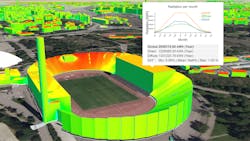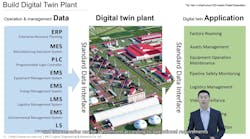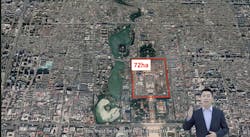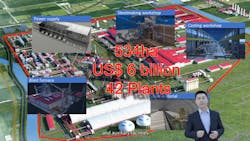At a Glance:
- Analysts argue greater stock should be placed in the effectiveness of disruptive digital twins designed in open, cloud-based environments because they evolve as software capabilities advance.
- A Chinese steelmaker is relocating an 89-year-old factory to a neighboring province. The plan included the development of a digital twin for the factory.
- Digital twins pay dividends in the way engineers design products or the way manufacturers operate systems.
- Digital twins, often associated with the design or build phase, can be extended to the operations and maintenance environment.
Beijing, one of the most polluted cities in world, went through an aggressive program to improve its notoriously poor air quality ahead of the 2008 Beijing Olympics. With a spotlight on the city, the Chinese government was motivated to improve air quality. Since then, the Chinese authorities have introduced a national action plan along with a raft of measures, including better regulation of polluting activities and a factory relocation effort.
When the Winter Olympics are held in Beijing next year, the world will have a chance to gauge the effects of those efforts, including China’s undertaking to relocate a significant part of its steel-producing capacity from the capital to a neighboring province. Located relatively near Beijing’s Winter Olympics arena, the Xuanhua Iron and Steel Plant is among those earmarked for relocation.
Not unlike its steel competitors, the Xuanhua facility, a subsidiary of China’s second-biggest steelmaker, HBIS Group Co., is gunning to reorganize on the basis of new demands for competition and efficiency. Relocating the 89-year-old factory to the Leting Economic Development Zone in Tangshan City in China’s Hebei province includes plans to develop a digital model for the factory.
The project is an ambitious effort that aims for structural transformation with the construction of an advanced, efficient, low-pollution, green and intelligent modern plant, noted He Zhang, Project BIM manager, MCC Capital Engineering & Research Incorporation (CERI), the organization hired as general engineering, procurement and construction contractor on the project.
The sheer scale of the relocation project, covering 534 hectares (5.34 km2) and worth $6 billion (RMB 40 billion), posed extreme difficulty. Since the project is cross-disciplinary—involving equipment, infrastructure, industrial pipelines, ventilation, dust removal and electrical bridges—figuring out how to co-ordinate the digital deliverables amongst stakeholders and building a digital model consistent with process flow of the actual factory was a challenge, noted Zhang.
For one, the production line generating hundreds of megabytes of data per second, would require high fidelity, real-time monitoring and automation that could drive the digital model and synchronize the digital twin factory with the physical factory.
Advances in digital twin simulation can inform where and how to focus and enforce action on projects of this scale, said Anne-Marie Walters, global marketing director, Bentley Systems, a global infrastructure engineering software company with headquarters in Exton, Penn. MCC CERI turned to Bentley Systems for tools (ProjectWise, AssetWise, Synchro and ContextCapture) to build a digital factory that could synchronize the design, construction, delivery and operation with the physical factory.
Among its short-term gains, MCC CERI was able to shorten the design cycle by 35 days and reported that the digital factory approach enabled commissioning cost reductions of 75%. In addition, the digital capability to simulate production is enabling production process improvements. The company estimated a typical operational saving of 60-70% reduction in energy consumption could be achieved by optimizing the operation of a shot blasting machine.
Prototype or Archetype
For all the hype or hesitation about its worth, digital twins pay dividends in the way engineers design products or the way manufacturers operate systems.
The aerospace, automotive, process and healthcare industries have long demonstrated the technology’s value with digital versions of physical objects and processes that enhance decision-making and quantify uncertainty. These industries have demonstrated that the potential of digital twin technology extends beyond the virtual representation of an as-built object or system.
The term "digital twins"is ubiquitously used to refer to a digital representation of a physical object or virtual model. The concept can be traced back to Michael Grieves, chief scientist for Advanced Manufacturing at Florida Institute of Technology, whose model was a bedrock for product lifecycle management.
But it was John Vickers, a principal technologist in the area of advanced materials and manufacturing at NASA, who actually coined the term. "Grieves and Vickers] started to link everything to something physical," said Jan de Nijs, LM fellow for Enterprise Digital Production, Lockheed Martin. "They started to focus on the twin—things that come in twos."
By this definition, a description of a product or process that does not have a real-world counterpart ought to be distinguished as a "digital prototype," argued de Nijs during a virtual presentation at the AMT Technology Forum. Without a real-world counterpart it is "aspirational" and is still valuable, de Nijs pointed out.
The growing popularity of the technology has spurred the need for a set of protocols for designing, making and maintaining digital twins. ISO 23247, for example, is a digital frameworkfor manufacturing, physical assets and processes, which maintains that the digital twin comprises an observable manufacturing element (which is not technically part of the twin), a process of observation that can collect data (typically retrieved by sensors), a virtual platform or model displaying what is observed, as well as a method for learning and making improvements or corrective actions.
Arguably, any confusion about what a "true" digital twin is may be chalked up to a lack of clarity as software vendors posit competing definitions based either on a specific approach or implementation. What has become clear are types of digital twins and the roles they perform in a given context.
Depending on the industry application,expertshighlight a few common features. An archetype might involve the design of a detailed virtual model of the physical object, ranging from an airplane, a building or a city, to critical equipment at a refinery or a space shuttle. Digital twins rely on information sets acquired from Internet of Things (IoT) devices and sensors that are integrated with physical assets.
When tied together, the "digital thread"facilitates an interplay of the physical and digital assets with a capacity for dynamic model updating. The mature virtual model is capable of performing analyses and computer simulations, providing insights on how to improve efficiency, de-risk and prevent failure.
Consider avionics, where digital twins can offer a huge benefit in predicting and solving potential problems. Aviation manufacturers, including Boeing and Lockheed Martin, incorporate digital twin technology into their working models of either the airplane or engine components. The technology is used to maintain the aircraft, as well as to map out ways to automate adaptations to changes, such as weather conditions, without human intervention.
When applied to the automotive industry, look to Tesla Motors for the consummate example of using digital twin technology to enhance reliability and service offerings. Each vehicle is connected to a digital twin geared for the after-sale phase of the product lifecycle. On a rolling basis, Tesla updates software from the factory based on the vehicles’ sensor data. Drivers download updates from the vehicle's touchscreen.
Cost efficiencies are realized when manufacturers are able to design, test, manufacture and support a product virtually. Factors such as context, the ability to perform simulations and the time framework have become foundational to making possible simulations for some of the world's largest digital twin projects, said Walters.
The task of moving work to the virtual world from the physical world requires massive computational power and mathematical modeling to analyze what-if scenarios and make predictions. This is especially relevant in infrastructure projects, where achieving digital twins at scale pose unique challenges. "The data often comes through sensors picked up from the plant, but it also could be how the asset itself has changed over time," said Walters. Applying analysis to context-based or time-based data to predict, simulate or "think forward in terms of what's going to happen" is critical.
Inspection Services
More often than not, digital twins are thought of in the design or build sense. But that association is changing as digital twins are extended to the operations and maintenance environment.
One of Bentley’s partners, Rocketmine, a London-based provider of industrial inspection services is a case in point. Due to COVID-19 restrictions, engineers were unable to travel to clients in South Africa and a limited number of people were allowed on site, recalled Walters. Combining the power of drones, laser scanning, mixed reality (Microsoft HoloLens 2) and remote-assist applications with the integrative capabilities of digital twins made inspections more accessible and inspired innovative coping methods during this time.
Rocketmine described its digital twin facility as an all-encompassing system that uses photogrammetric drones and LiDAR scanners to develop a 3D model of the real-world assets. The model includes the labor-intensive work of digitally itemizing and geolocating individual components of the physical assets and classifying part-related information (such as part ID, manufacturer, model number, installation date, service and maintenance data, and PDF manuals). Live asset data such as temperatures and flow rates are centralized so users can digitally visualize and monitor the component in real-time.
In this scenario the digital twin becomes an immersive, holistic reflection of the site because reality data, engineering data and IoT data were collected from the design to the building and operational phases as a way to enhance asset planning, maintenance and management. Predictive maintenance is enabled, operational efficiency enhanced and failure costs and downtime can be proactively averted.
During the pandemic inspectors communicated with the London office by sharing visuals of what was happening on site, said Walters. Engineers in London could perform remote inspections and risk assessments with an immersive view of the actual site. An inspector on site could use Microsoft’s HoloLens integrated 3D scanning technology to view and feed information to the model. Coupled with artificial intelligence (AI) and machine learning (ML), the digital twin not only enables better forecasting, but also simulates outcomes and augments safety, said Walters.
Time to First Oil
A barrier to implementing digital twins is that data flowing from multiple sources can introduce inaccuracies and open the prospect for interoperability and standardization issues. But analysts counter that greater stock should be placed in the effectiveness of disruptive digital twins designed in open, cloud-based environments because they evolve as software capabilities advance.
Look no further than Shell’s Deep Water project in the Gulf of Mexico for an example. In situations where oil and gas companies are under pressure to ensure their investments deliver big returns, digital twins can provide the innovation needed for streamlining processes and making end-to-end decisions.
"These days, it’s harder for oil companies to get money to exploit and develop new assets," said Walters. Shell recognized an opportunity to use digital twin technology to deliver several subsea tie-back projects. "They discover a well some ways away from a facility," Walters explained. "It might not be enough to build a new facility to exploit that oil, so they need to tie back the wells to existing infrastructure."
The scope of Shell’s project included the completion of at least 50 tie-backs over the course of the next 10 years. "Each project typically takes five years, and they simply cannot afford that time scale," said Walters. "They’re looking to significantly reduce the time it takes to develop a tie-back project. They’re trying to shave a whole year off what typically takes five years."
Engineers figured out that the best way to tie the well back to existing infrastructure was to develop an integrated workflow and data platform. They pulled together subsea information—such as what the terrain of the sea surface looked like, reservoir information and the resources they could plunk on the seabed—before integrating the flow of information with existing infrastructure. "All of this in order to make a decision about what would be the best way to conduct a tie-back and hand over the digital data to the operations and maintenance teams," said Walters.
Return on Experience
Another hurdle for implementing digital twins involves the volume of data required and the labor-intensive nature of training models to understand what-if scenarios. Yet, digitalization, computational bandwidth, AI and machine learning tools are proving to be more beneficial and more accessible than ever for industries battling challenging market conditions.
Gartnerresearch revealed that at least a third of mid-to-large-size companies that implemented IoT will have implemented at least one digital twin associated with a COVID-19-motivated use case by 2023. Analysts further report an increasing demand for digital twins across industries. The global digital twin market is on course to reach $48.2 billion by 2026, according to MarketsandMarkets.
Regardless of the application context, the digital twin is capable of synchronizing data from the physical asset’s state and operating condition in real-time over the course of its lifecycle. "An important point," said Nijs, "is that when we’re going to define digital twins for specific use cases, we’re also going to flow those down to our supply chain, whether it’s internally or externally. In the future, it shouldn’t matter where the part came from."
Supply chain optimization that encapsulates end-to-end visibility and accommodates extemporaneous adjustments can greatly reduce risk through constant monitoring and early warning, report analysts. Farsighted organizations will do the legwork to improve project and asset performance. Besides, added Nijs, digital twins don’t need to be perfect to show value.
Central to the success of decision-making platforms is the ability to eliminate barriers. For their efforts, an independent panel of judges named MCC CERI's factory relocation project the winner in the manufacturing category at Bentley Systems’ Year in Infrastructure 2020 AwardsThe validation is a small step in the direction toward implementing digital twins for sustainable manufacturing practices.
One of the benefits of operating in an interoperative environment is that it fosters innovation. Engineering firms that have had a 30-year history with Bentley are beginning to change their business models, noted Walters. This was demonstrated at both the Shell Deep Water subsea environment and the Xuanhua Iron and Steel Plant. "They are moving from doing pure projects to being more of a digital partner with their clients, and they are driving and pushing [Bentley] to automate a lot more of the workflows," she said.
The effects of these collaborations have fostered automation and digitalization services, including the use of AI and ML in industries that have historically lacked the digital maturity relative to their contractors.
It also galvanizes the next evolution: digital twins designed to mirror reality are giving way to models that drive reality. For Bentley, said Walters, that means developing more partnerships with a focus on industry-specific digital twins that can harness off-the-shelf solutions and automation tools to drive business.
Walters envisions a more benevolent future: "I’m thinking way out—and this is Audrey thinking with my chemical engineering hat on, if you like; I don’t think it’s going to be too long before we’re able to scan a process plant and figure out how much carbon it’s producing and how to make that plant more carbon neutral with a digital twin service that is very much focused on looking at that problem."
At the rate of digital advancement and with an infrastructure and jobs package at the center of President Biden’s economic agendasweeping changes and progressive solutions born from innovative thinking are likely more imminent than abstraction.
About the Author

Rehana Begg
Editor-in-Chief, Machine Design
As Machine Design’s content lead, Rehana Begg is tasked with elevating the voice of the design and multi-disciplinary engineer in the face of digital transformation and engineering innovation. Begg has more than 24 years of editorial experience and has spent the past decade in the trenches of industrial manufacturing, focusing on new technologies, manufacturing innovation and business. Her B2B career has taken her from corporate boardrooms to plant floors and underground mining stopes, covering everything from automation & IIoT, robotics, mechanical design and additive manufacturing to plant operations, maintenance, reliability and continuous improvement. Begg holds an MBA, a Master of Journalism degree, and a BA (Hons.) in Political Science. She is committed to lifelong learning and feeds her passion for innovation in publishing, transparent science and clear communication by attending relevant conferences and seminars/workshops.
Follow Rehana Begg via the following social media handles:
X: @rehanabegg
LinkedIn: @rehanabegg and @MachineDesign








